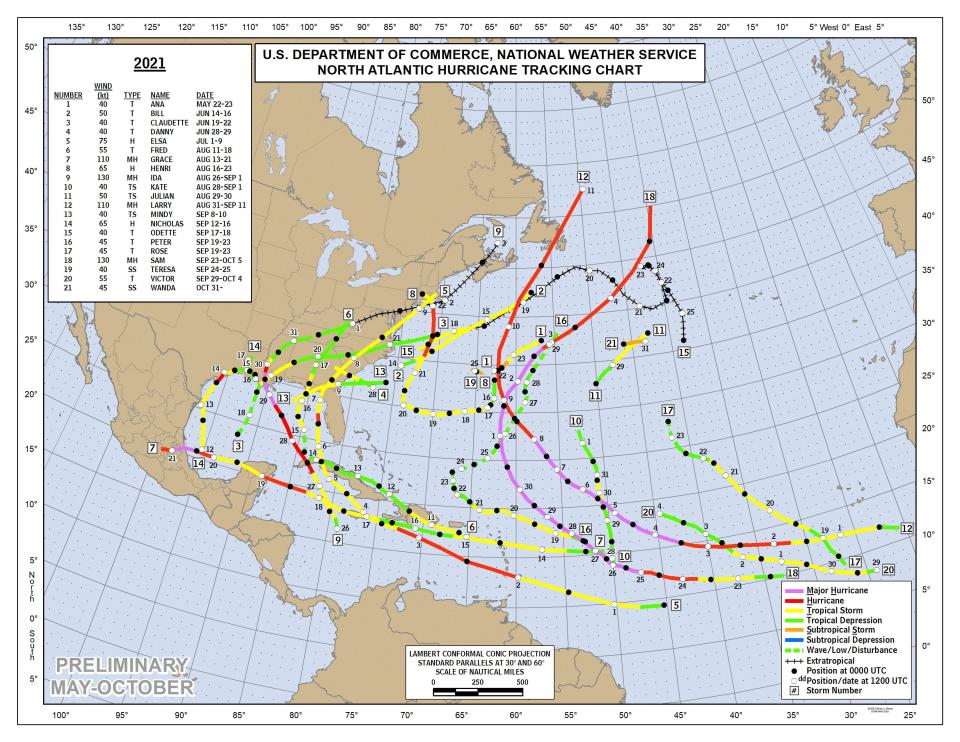The 2021 hurricane season was busy (again), but ended quietly, sparing Volusia County

As Atlantic hurricane season officially ended this week, Volusia County residents can breathe a sigh of relief.
The area was spared a direct hit from this year's 21 named storms.
"It was a very active season. We were just extremely fortunate the storms turned away from us," Volusia County Emergency Management Director Helene Wetherington said.
Hurricane season typically runs from the beginning of June to the end of November, but 2021 has an early start, with the first named storm forming May 22.
Of the 21 named storms, eight hit the U.S., an above-average season that still paled in comparison to the record-shattering 30 storms and 12 U.S. landfalls that set climatologists on edge in 2020.
It's the sixth consecutive year with above-normal activity.
A warming climate: Overnight low temperatures are rising in Florida faster than daytime highs. Here's why.
The impact of floods: November's heavy rains caused sewer spills in parts of Daytona Beach, Holly Hill
A bit of good news 🐢: For third year in a row, Volusia County records hundreds more sea turtle nests than average
For the second year in a row, the list of storm names was exhausted, but thanks to an unusually quiet fall, the 2021 season stopped just short of having to turn to a new list of alternative names approved by the World Meteorological Organization.
"This year we had Henri, Ida and Fred causing billions of dollars in damages," said AccuWeather lead hurricane forecaster Dan Kottlowski. "Ida was by far the worst."
Hurricane Ida hit Louisiana hard, killing more than 90 people in nine U.S. states as it spun into the Northeast, dumping inches of rain along the way.
The majority of deaths were from drowning, but Wetherington noted 17 died due to carbon monoxide poisoning during power outages.
"We always say 'Run from the water. Hide from the wind,' when a storm is approaching," Wetherington noted. "But I think it's so important that people also understand they need to read the instructions for generators very closely."
Wetherington said as the scientific community predicts climate change will continue intensifying hurricane activity, it's more important than ever to make sure your home is floodproof and wind-resistant and residents have evacuation plans in place.
"When hurricanes don’t hit us we tend to forget about them. In a way, it’s just the luck of the draw. Keep in mind it only takes one coming our way," she said.
NOAA's National Hurricane Center reported Wednesday that the accumulated cyclone energy, the strength and duration of all the tropical storms and hurricanes in the basin, was about 20% above the long-term average.
Hurricane season typically peaks in September. Meteorologists had anticipated an active end of the season, but it mercifully fizzled, with a single harmless storm forming in the months of October and November.
"I was saying ocean temperatures are warmer than average and waters off Mexico and Florida are warm and there’s La Niña, so odds are we are going to get an active end of season," said Jeff Masters, a meteorologist for Yale Climate Connections and a co-founder of Weather Underground. "But the weather and climate system is chaotic. It doesn’t always behave in the way people expect it to."

All the named storms of the 2021 Atlantic Hurricane Season
In 2021, there were 14 tropical storms:
Ana: Maxed out at 45 mph winds (May 22-23)
Bill: Maxed out at 65 mph winds (June 14-15)
Claudette: Maxed out at 45 mph winds (June 19-22)
Danny: Maxed out at 45 mph winds (June 27-29)
Fred: Maxed out at 65 mph winds (Aug. 11-18)
Julian: Maxed out at 60 mph winds (Aug. 28-30)
Kate: Maxed out at 45 mph winds (Aug. 28 - Sept. 1)
Mindy: Maxed out at 45 mph winds (Sept. 8-10)
Odette: Maxed out at 45 mph winds (Sept. 17-18)
Peter: Maxed out at 50 mph winds (Sept. 19-22)
Rose: Maxed out at 50 mph winds (Sept. 19-23)
Teresa: Subtropical cyclone maxing out at 45 mph winds (Sept. 24-25)
Victor: Maxed out at 65 mph winds (Sept. 29 - Oct 4)
Wanda: Maxed out at 50 mph winds (Oct. 31 - Nov. 7)
There were seven hurricanes, including four major hurricanes:
Elsa: Category 1 hurricane maxing out at 85 mph winds (July 1-9)
Grace: Category 3 hurricane maxing out at 125 mph winds (Aug. 13-21)
Henri: Category 1 hurricane maxing out at 75 mph winds (Aug. 16-23)
Ida: Category 4 hurricane maxing out at 150 mph winds (Aug. 26 - Sept. 1)
Larry: Category 3 hurricane maxing out at 125 mph winds (Aug. 31 - Sept. 11)
Nicholas: Category 1 hurricane maxing out at 75 mph winds (Sept. 12-16)
Sam: Category 4 hurricane maxing out at 150 mph winds (Sept. 22 - Oct. 5)
An average Atlantic hurricane season has 14 named storms and seven hurricanes (three of which are major hurricanes), according to the National Hurricane Center.
Palm Beach Post reporter Kimberly Miller contributed to this story.
This article originally appeared on The Daytona Beach News-Journal: No storms hit Volusia County in 'very active' 2021 hurricane season

